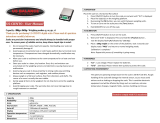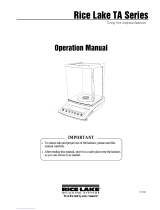ADVENTURER BALANCES EN-1
TABLE OF CONTENTS
1. INTRODUCTION .................................................................................................................... 3
1.1 Description ................................................................................................................................................... 3
1.2 Features ....................................................................................................................................................... 3
1.3 Definition of Signal Warnings and Symbols ................................................................................................. 3
1.4 Safety Precautions ....................................................................................................................................... 3
1.5 Intended Use ................................................................................................................................................ 3
2. INSTALLATION ..................................................................................................................... 5
2.1 Unpacking .................................................................................................................................................... 5
2.2 Selecting the Location .................................................................................................................................. 5
2.3 Leveling the Equipment ................................................................................................................................ 5
2.4 Connecting Power ........................................................................................................................................ 6
2.5 Connecting the Interface .............................................................................................................................. 6
2.6 Initial Calibration ........................................................................................................................................... 6
3. OPERATION .......................................................................................................................... 7
3.1 Overview of Display, Home Screen ............................................................................................................. 7
3.2 Principal Functions and Main Menu ............................................................................................................ 8
3.3 Overview of Parts and Features – Draft Shield Models ............................................................................... 9
3.4 Overview of Parts and Features – Non Draft Shield Models ....................................................................... 9
4. APPLICATIONS ................................................................................................................... 10
4.1 Weighing .................................................................................................................................................... 10
4.1.1 Item Settings .......................................................................................................................................... 11
4.1.2 Sample Name ......................................................................................................................................... 12
4.1.3 Save to USB ........................................................................................................................................... 12
4.1.4 Auto Save to USB .................................................................................................................................. 12
4.2 Parts Counting ........................................................................................................................................... 12
4.2.1 Item Settings .......................................................................................................................................... 13
4.3 Percent Weighing ....................................................................................................................................... 15
4.3.1 Item Settings .......................................................................................................................................... 15
4.4 Dynamic Weighing ..................................................................................................................................... 16
4.4.1 Item Settings .......................................................................................................................................... 16
4.5 Density Determination ................................................................................................................................ 17
4.5.1 Measuring the Density of a Solid Using Water (default) ........................................................................ 17
4.5.2 Measuring the Density of a Buoyant Material Using Water ................................................................... 18
4.5.3 Measuring the Density of a Solid Using an Auxiliary Liquid ................................................................... 18
4.5.4 Measuring the Density of a liquid using a Calibrated Sinker (not supplied) ........................................... 19
4.5.5 Measuring the Density of Porous Material Using Oil ............................................................................. 20
4.6 Check Weighing ......................................................................................................................................... 22
4.6.1 Item Settings .......................................................................................................................................... 23
4.7 Display Hold ............................................................................................................................................... 23
4.7.1 Display Hold ........................................................................................................................................... 23
4.7.2 Peak Hold ............................................................................................................................................... 24
4.7.3 Item Settings .......................................................................................................................................... 24
4.8 Totalization ................................................................................................................................................. 24
4.9 Formulation ................................................................................................................................................ 25
4.9.1 Item Settings .......................................................................................................................................... 26
4.10 Additional Features .................................................................................................................................... 27
4.10.1 Weigh Below .......................................................................................................................................... 27
5. MENU SETTINGS ................................................................................................................ 28
5.1 Menu Navigation ........................................................................................................................................ 28
5.1.1 Changing Settings .................................................................................................................................. 29
5.2 Calibration .................................................................................................................................................. 30
5.2.1 Calibration sub-menu (InCal models) ..................................................................................................... 30
5.2.2 Internal Calibration ................................................................................................................................. 30
5.2.3 Automatic Calibration ............................................................................................................................. 30
5.2.4 AutoCal™ Adjustment ............................................................................................................................ 31
5.2.5 Span Calibration ..................................................................................................................................... 31
5.2.6 Linearity Calibration ................................................................................................................................ 31
5.2.7 Calibration Test ...................................................................................................................................... 31
5.3 Balance Setup ............................................................................................................................................ 32
5.3.1 Balance Set-up sub-menu ...................................................................................................................... 32
























